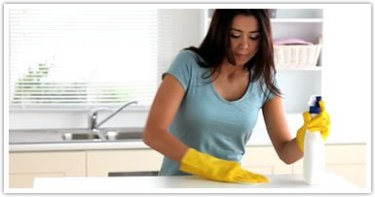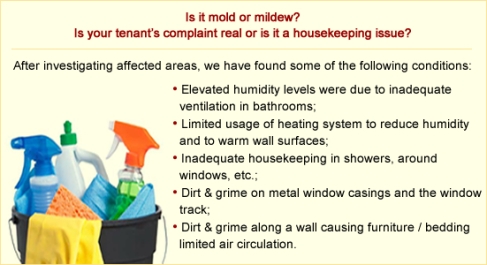By James F. McClung, Jr
 Property owners and management companies know how hard it is to find and keep good tenants. If a tenant complains about suspected mold, it’s important to take it seriously. Having vendors in place, (mold consultants and remediation contractors), allows a property owner or management company to react quickly to a mold complaint. A quick reaction keeps the tenant satisfied and is essential in minimizing risks for potential liability concerns. Owners, property management, and builders are being sued in record numbers over issues of mold. There are many avenues for managing microbial issues on a low-key and cost-effective basis that can provide solutions and reduce the potential for liability. This industry has a lot of hype. What is the right course of action?
Property owners and management companies know how hard it is to find and keep good tenants. If a tenant complains about suspected mold, it’s important to take it seriously. Having vendors in place, (mold consultants and remediation contractors), allows a property owner or management company to react quickly to a mold complaint. A quick reaction keeps the tenant satisfied and is essential in minimizing risks for potential liability concerns. Owners, property management, and builders are being sued in record numbers over issues of mold. There are many avenues for managing microbial issues on a low-key and cost-effective basis that can provide solutions and reduce the potential for liability. This industry has a lot of hype. What is the right course of action?
What you don’t know can cost you money!
The California Department of Health Services describes mold as “…simple, microscopic organisms found virtually everywhere, indoors and outdoors.” Therefore, there is no such thing as a residence being free of mold spores, as they are found indoors and outdoors. Mold has been around for a very long time; early references can be found in the Bible.
Many wonder why mold has become more publicized than ever before. In recent years, testing methods have become more sophisticated, diagnostic capabilities have improved, and the general public has more access to information. Changes in building materials utilized since the 1970’s are more susceptible to mold growth. An example is the former use of lath and plaster walls compared to the current, less expensive use of drywall. Drywall contains a paper backing and lath and plaster does not. Whenever sufficient moisture is present, the paper backing on drywall may promote the growth of mold. Many potential moisture intrusion sources exist in single and multi-family residences such as bathrooms (sinks, tub, shower enclosures, toilets), kitchens (sinks, dishwashers, icemakers), laundry rooms, and various types of plumbing throughout the structure. There are outside sources that can also affect the interior including, sprinklers, poor drainage, plugged exterior ground drains, flowerbeds raised above concrete slab levels and of course, roof leaks.
Mold cannot grow without a moisture intrusion source and a porous material, (i.e., drywall, carpeting, wood). Mold will usually be embedded in the affected material and cannot be easily wiped off. To remediate mold, it may be necessary to cut out and conduct remediation activities in the affected area(s).
Mildew can often be mistaken for mold. Numerous studies have shown the relationship of elevated humidity levels, cool surfaces, and the effects of mildew growth. A common tenant complaint is mold growth in bathrooms; ceilings, walls and grout. Shower steam (humidity) will condense on cool surfaces (mirror, ceiling, windows and walls), and without adequate ventilation the humidity will remain on the various surfaces and not adequately dry. This may form a surface fungal growth, which is usually mildew. In addition, without adequate ventilation the humidity will escape into adjoining rooms once the bathroom door has been opened. The humidity will condense on cooler surfaces such as the interior of outside walls and windows. This condition is prevalent on north facing room walls and windows where direct sunlight does not have an opportunity to warm them. A fuzzy type of fungal growth, caused by humidity condensation and lack of ventilation, can also form on walls behind dressers, and in the corners of windows and window casings where there is dust or grime. In closets, it may be found on shoes or clothes.
 An easy way to tell if the microbial growth is on the surface vs. embedded in the substrate is to gently rub the surface with tissue. If the growth is easily wiped off, usually it will be a type of mildew. A general cleaning of all surfaces utilizing an anti-microbial can remove excess dust and residual microbial spores. Afterward, it will be necessary to find a solution to the elevated humidity levels to prevent a return of the microbial growth. Humidity levels can be reduced in bathrooms through either opening the window or installing a higher efficiency exhaust fan. For bedrooms, it may be necessary to utilize a portable dehumidifier. Through increased housekeeping of walls, windows, closets, furniture, and bathrooms, most microbial growth can be prevented. The key can be as simple as air movement, keeping surfaces clean, and reducing humidity.
An easy way to tell if the microbial growth is on the surface vs. embedded in the substrate is to gently rub the surface with tissue. If the growth is easily wiped off, usually it will be a type of mildew. A general cleaning of all surfaces utilizing an anti-microbial can remove excess dust and residual microbial spores. Afterward, it will be necessary to find a solution to the elevated humidity levels to prevent a return of the microbial growth. Humidity levels can be reduced in bathrooms through either opening the window or installing a higher efficiency exhaust fan. For bedrooms, it may be necessary to utilize a portable dehumidifier. Through increased housekeeping of walls, windows, closets, furniture, and bathrooms, most microbial growth can be prevented. The key can be as simple as air movement, keeping surfaces clean, and reducing humidity.
Regardless of the microbial growth, it is highly recommended that maintenance personnel, on-site management, or property owners respond promptly to tenant concerns. This includes all reports of mold, mildew, moisture intrusion, overflows, non-working heating and air conditioning systems, bathroom exhaust fans, bathroom ventilation windows, kitchen fans, kitchen vent systems, and laundry room exhausts. Each complaint should be investigated and documented including any appropriate responses for repairs and / or remediation activities.
Many times the tenant’s complaints can be easily solved without the need of an outside vendor. However, there will be times when an expert may be needed.
James McClung is the president of American Environmental Specialists, Inc. (AES), a veteran owned environmental consulting firm specializing in mold, lead-based paint, indoor air quality and asbestos. Since 1992, AES has provided due diligence inspections in the single and multi-family residential industry. Our mission is to provide our clients with the tools necessary to make informed, cost-effective decisions to mitigate property damage.
For more information: http://www.powerpropertymanagement.com/

